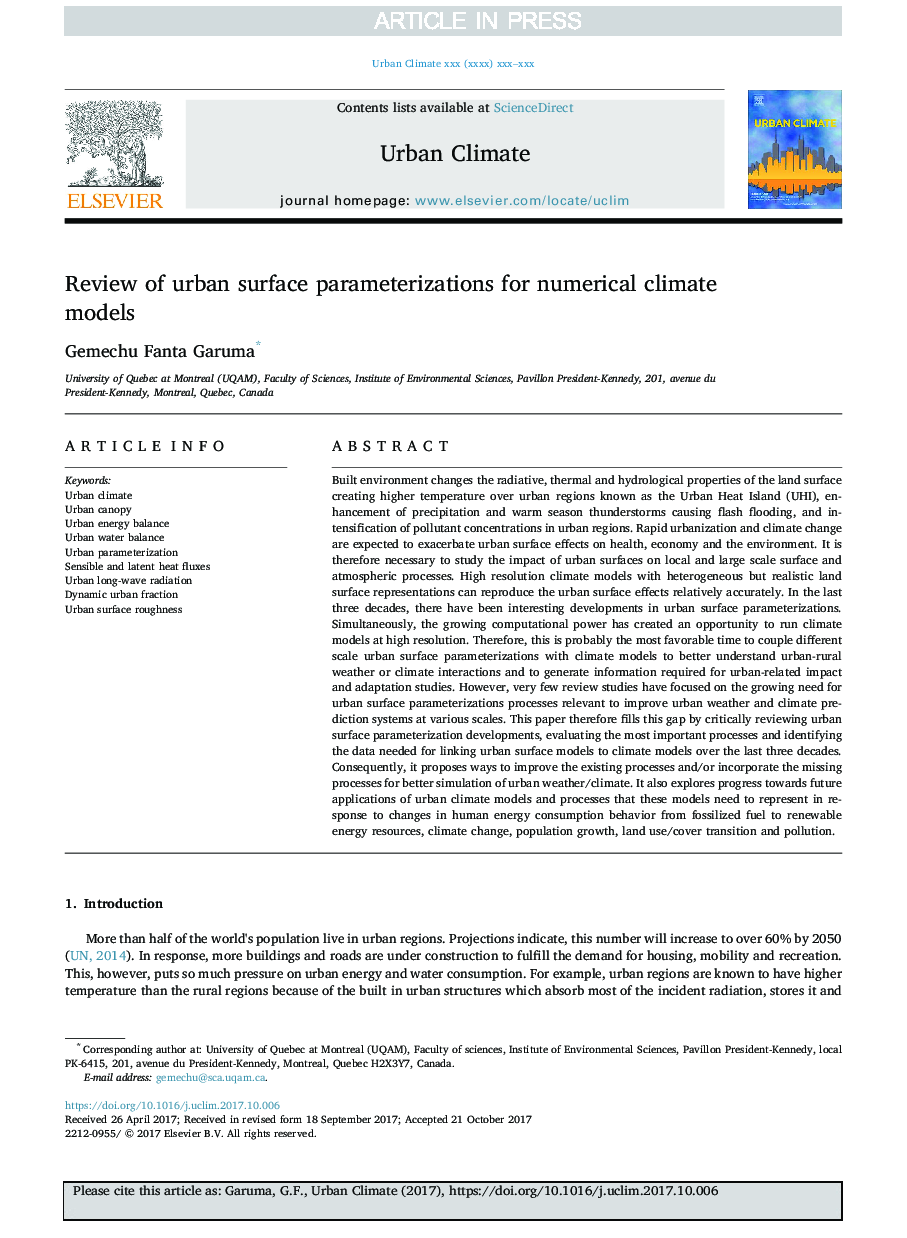| کد مقاله | کد نشریه | سال انتشار | مقاله انگلیسی | نسخه تمام متن |
|---|---|---|---|---|
| 6576925 | 1422839 | 2018 | 22 صفحه PDF | دانلود رایگان |
عنوان انگلیسی مقاله ISI
Review of urban surface parameterizations for numerical climate models
ترجمه فارسی عنوان
بررسی پارامترهای سطح شهر برای مدل های آب و هوایی عددی
دانلود مقاله + سفارش ترجمه
دانلود مقاله ISI انگلیسی
رایگان برای ایرانیان
کلمات کلیدی
آب و هوای شهری، سایبان شهری، تعادل انرژی شهری، تعادل آب شهری، پارامترهای شهری، شار حرارتی معقول و پنهان، تابش موج بلند شهری، کسر شهری دینامیکی، زبری سطح شهری،
ترجمه چکیده
محیط ساخته شده تغییرات خواص شعاعی، حرارتی و هیدرولوژیکی سطح زمین را ایجاد می کند و باعث ایجاد دمای بالاتر در مناطق شهری شناخته شده به عنوان جزیره گرمایی شهری می شود، افزایش بارش و رعد و برق فصل گرم باعث فلاش شدن و تشدید غلظت آلاینده ها در مناطق شهری می شود. انتظار می رود که شهرنشینی سریع و تغییرات آب و هوایی باعث افزایش اثرات سطح شهری بر سلامت، اقتصاد و محیط زیست شود. بنابراین لازم است تاثیر سطوح شهری در فرآیندهای سطحی و اتمسفر محلی و در مقیاس بزرگ مورد مطالعه قرار گیرد. مدل های آب و هوایی با وضوح بالا با نمایندگی های ناهمگن اما واقع بینانه سطح زمین می توانند نسبتا دقیق به سطح شهر بازتولید کنند. در سه دهه گذشته، تحولات جالب در پارامترهای سطح شهر رخ داده است. همزمان، قدرت محاسباتی رو به رشد فرصتی برای اجرای مدل های آب و هوایی با وضوح بالا ایجاد کرده است. بنابراین، احتمالا مناسب ترین زمان برای تحمیل پارامترهای پارامترهای سطح شهری با مدل های آب و هوایی برای درک بهتر تعاملات آب و هوایی شهری و روستایی و ایجاد اطلاعاتی است که برای مطالعات تأثیر و تأثیرات شهری ضروری است. با این حال، مطالعات بسیار کمی بررسی شده بر روی نیاز فزاینده به فرایندهای پارامترهای سطح شهر مربوط به بهبود سیستم های آب و هوا و سیستم های پیش بینی آب و هوای شهر در مقیاس های مختلف متمرکز شده است. بنابراین این مقاله با پرکردن نقاط تحول پارامترهای سطح شهر، ارزیابی مهمترین فرایندها و شناسایی داده های مورد نیاز برای اتصال مدل های سطح شهری به مدل های آب و هوایی طی سه دهه گذشته را پر می کند. در نتیجه، آن را راه هایی برای بهبود فرایندهای موجود و / یا ترکیب پروسه های از دست رفته برای شبیه سازی بهتر آب و هوا و آب و هوای شهر پیشنهاد می دهد. این همچنین پیشرفت هایی را در جهت استفاده های آینده از مدل های فضای شهری و فرآیندهای مورد نیاز برای نشان دادن این تغییرات در رفتار مصرف انرژی انسان از سوخت فسیلی به منابع انرژی تجدیدپذیر، تغییرات اقلیمی، رشد جمعیت، انتقال زمین و پوشش و آلودگی بررسی می کند.
موضوعات مرتبط
مهندسی و علوم پایه
علوم زمین و سیارات
علوم زمین و سیاره ای (عمومی)
چکیده انگلیسی
Built environment changes the radiative, thermal and hydrological properties of the land surface creating higher temperature over urban regions known as the Urban Heat Island (UHI), enhancement of precipitation and warm season thunderstorms causing flash flooding, and intensification of pollutant concentrations in urban regions. Rapid urbanization and climate change are expected to exacerbate urban surface effects on health, economy and the environment. It is therefore necessary to study the impact of urban surfaces on local and large scale surface and atmospheric processes. High resolution climate models with heterogeneous but realistic land surface representations can reproduce the urban surface effects relatively accurately. In the last three decades, there have been interesting developments in urban surface parameterizations. Simultaneously, the growing computational power has created an opportunity to run climate models at high resolution. Therefore, this is probably the most favorable time to couple different scale urban surface parameterizations with climate models to better understand urban-rural weather or climate interactions and to generate information required for urban-related impact and adaptation studies. However, very few review studies have focused on the growing need for urban surface parameterizations processes relevant to improve urban weather and climate prediction systems at various scales. This paper therefore fills this gap by critically reviewing urban surface parameterization developments, evaluating the most important processes and identifying the data needed for linking urban surface models to climate models over the last three decades. Consequently, it proposes ways to improve the existing processes and/or incorporate the missing processes for better simulation of urban weather/climate. It also explores progress towards future applications of urban climate models and processes that these models need to represent in response to changes in human energy consumption behavior from fossilized fuel to renewable energy resources, climate change, population growth, land use/cover transition and pollution.
ناشر
Database: Elsevier - ScienceDirect (ساینس دایرکت)
Journal: Urban Climate - Volume 24, June 2018, Pages 830-851
Journal: Urban Climate - Volume 24, June 2018, Pages 830-851
نویسندگان
Gemechu Fanta Garuma,
